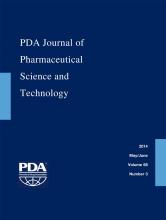Abstract
Typical platform processes for biopharmaceutical products derived from animal cell lines include a parvovirus filtration unit operation to provide viral safety assurance of the drug product. The industry has adopted this platform unit operation and gained a wider understanding of its performance attributes, leading to the possibility of streamlined approaches to virus clearance validation. Here, the concept of virus validation on a parvovirus-grade filter with a single worst-case model virus is presented. Several lines of evidence, including published literature and Amgen's own data, support the use of a parvovirus, such as mouse minute virus (MMV), as a worst-case model virus to assess virus removal by parvovirus filters. The evidence presented includes a discussion of the design and manufacture of virus filters with a size exclusion mechanism for removal. Next, the characteristics of different model viruses are compared and a risk assessment on the selection of the relevant model viruses for clearance studies is presented. Finally, a comprehensive summary of literature and Amgen data is provided, comparing the clearance of larger viruses against MMV. Together, this analysis provides a strong scientific rationale for the use of a single, worst-case model virus for assessing virus removal by parvovirus filters, which will ultimately allow for more efficient and streamlined viral clearance study designs.
LAY ABSTRACT: Demonstrating the virus clearance capability of a purification process is an important aspect of biopharmaceutical process development. A key component of the viral safety of the process is the inclusion of a parvovirus-grade filter as an effective and robust virus removal step. Traditional methodologies for viral clearance studies have been based on a conservative, data-intensive approach, but recent trends in the field of virus clearance and process development show evolution towards streamlined and more efficient study designs that are based on understanding the mechanism of viral clearance by downstream unit operations. The publication of scientific datasets and awareness of the underlying mechanisms involved with these unit operations have fueled this trend. Here, the concept of virus validation on a parvovirus-grade filter using a parvovirus as single, worst-case model virus is presented. Multiple lines of evidence are provided to support this proposal, including a review of published literature and Amgen historical data. The adoption of this approach provides benefits in terms of cost savings for executing viral clearance studies, but it also simplifies the necessary dataset and focuses on only supplying value-added information to demonstrate the viral safety of the process.
- © PDA, Inc. 2014
PDA members receive access to all articles published in the current year and previous volume year. Institutional subscribers received access to all content. Log in below to receive access to this article if you are either of these.
If you are neither or you are a PDA member trying to access an article outside of your membership license, then you must purchase access to this article (below). If you do not have a username or password for JPST, you will be required to create an account prior to purchasing.
Full issue PDFs are for PDA members only.
Note to pda.org users
The PDA and PDA bookstore websites (www.pda.org and www.pda.org/bookstore) are separate websites from the PDA JPST website. When you first join PDA, your initial UserID and Password are sent to HighWirePress to create your PDA JPST account. Subsequent UserrID and Password changes required at the PDA websites will not pass on to PDA JPST and vice versa. If you forget your PDA JPST UserID and/or Password, you can request help to retrieve UserID and reset Password below.






